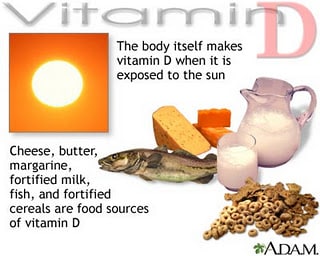Vitamin D – Are you Getting Enough of This “Super” Nutrient?
Vitamin D has always been known as the bone-building vitamin. However, are you aware that almost every human cell in our body relies on it? If you are deficient in this vitamin, your body will fail to work at its potential – including your metabolism. Experts believe that up to 77 percent of Americans are vitamin D deficient (defined as having blood levels of less than 30 nanograms per milliliter). So why do we come up so short, especially since vitamin D is one of the few vitamins our bodies can make? Sunlight converts a cholesterol-like substance naturally found in the skin into D. The challenge is, thanks to UV rays and skin cancer, soaking up sun to make more D would do you more harm than good. For your skin to make enough vitamin D, you would need direct midday summer sunlight on a huge portion of your body for 15 minutes a day—risking serious sun damage. It’s even more difficult for people of color to make D as the melanin in dark skin decreases vitamin D production by up to 90 percent.
In the past few years, research has suggested that vitamin D might help relieve mood disorders because it seems to increase the amounts of serotonin, one of the neurotransmitters responsible for mood. In particular, vitamin D seems to help the type of depression called “seasonal affective disorder (SAD),” or the winter blues. Vitamin D also plays a positive role in heart disease, metabolism, pregnancy problems, birth defects, skin and other cancers such as colon, breast, and prostate, and multiple sclerosis. As a result, vitamin D’s daily requirements for adults have increased from 200 IUs to at least 600 IUs, and possibly more. I recommend that my clients first have their vitamin D levels checked and then for most, to take 1,000 IUs daily.
Wondering what foods and beverages are rich in vitamin D? The next time you visit the grocery store, look for fish such as salmon with bones, fat free or low-fat fortified milk, fortified soy milk and egg yolks. Because vitamin D-rich foods are so limited, it’s often beneficial to take a daily multivitamin with 600 IUs of vitamin D3. With the New Year upon us, I encourage you to have your vitamin D level checked the next time you visit your physician. Keep me posted! Wishing you a healthy and successful 2012.

Chrissy Barth
MS RDN RYT
The EPIC Biology sports nutrition blog is a resource for athletes of all ages. If you’re looking to gain a competitive advantage by optimizing your performance and improving overall wellness, you’ve come to the right place.
Unlock Your Body’s Potential EVERY DAY
Ready to ask yourself crucial questions about your health every day? We’ll help you knock it out of the park with a simple, easy-to-use checklist.
Ready to take your performance to the next level?
I’m here to help.
If you’re looking for individualized, sustainable sports nutrition guidance, let’s chat. Schedule a free 15-minute call so that we can get to know each other, then establish your next steps.
Vitamin D has always been known as the bone-building vitamin. However, are you aware that almost every human cell in our body relies on it? If you are deficient in this vitamin, your body will fail to work at its potential – including your metabolism. Experts believe that up to 77 percent of Americans are vitamin D deficient (defined as having blood levels of less than 30 nanograms per milliliter). So why do we come up so short, especially since vitamin D is one of the few vitamins our bodies can make? Sunlight converts a cholesterol-like substance naturally found in the skin into D. The challenge is, thanks to UV rays and skin cancer, soaking up sun to make more D would do you more harm than good. For your skin to make enough vitamin D, you would need direct midday summer sunlight on a huge portion of your body for 15 minutes a day—risking serious sun damage. It’s even more difficult for people of color to make D as the melanin in dark skin decreases vitamin D production by up to 90 percent.
In the past few years, research has suggested that vitamin D might help relieve mood disorders because it seems to increase the amounts of serotonin, one of the neurotransmitters responsible for mood. In particular, vitamin D seems to help the type of depression called “seasonal affective disorder (SAD),” or the winter blues. Vitamin D also plays a positive role in heart disease, metabolism, pregnancy problems, birth defects, skin and other cancers such as colon, breast, and prostate, and multiple sclerosis. As a result, vitamin D’s daily requirements for adults have increased from 200 IUs to at least 600 IUs, and possibly more. I recommend that my clients first have their vitamin D levels checked and then for most, to take 1,000 IUs daily.
Wondering what foods and beverages are rich in vitamin D? The next time you visit the grocery store, look for fish such as salmon with bones, fat free or low-fat fortified milk, fortified soy milk and egg yolks. Because vitamin D-rich foods are so limited, it’s often beneficial to take a daily multivitamin with 600 IUs of vitamin D3. With the New Year upon us, I encourage you to have your vitamin D level checked the next time you visit your physician. Keep me posted! Wishing you a healthy and successful 2012.

